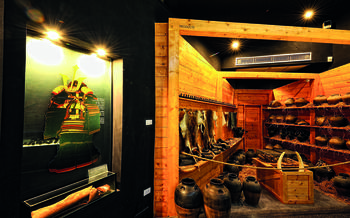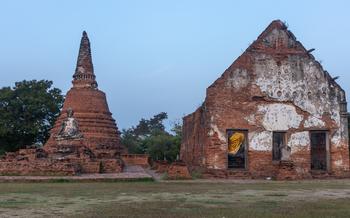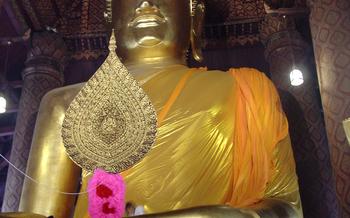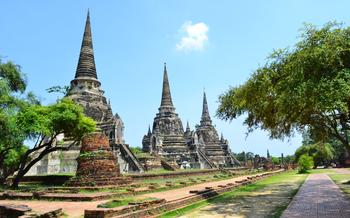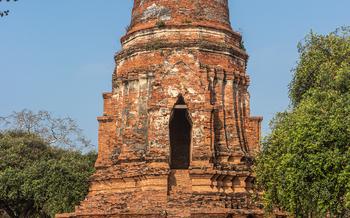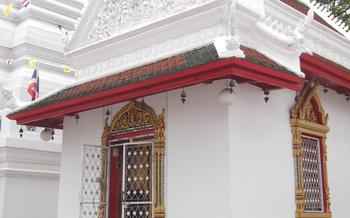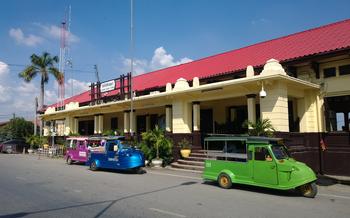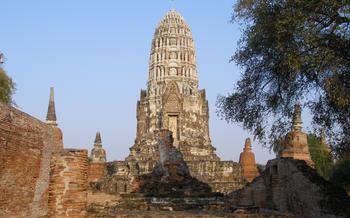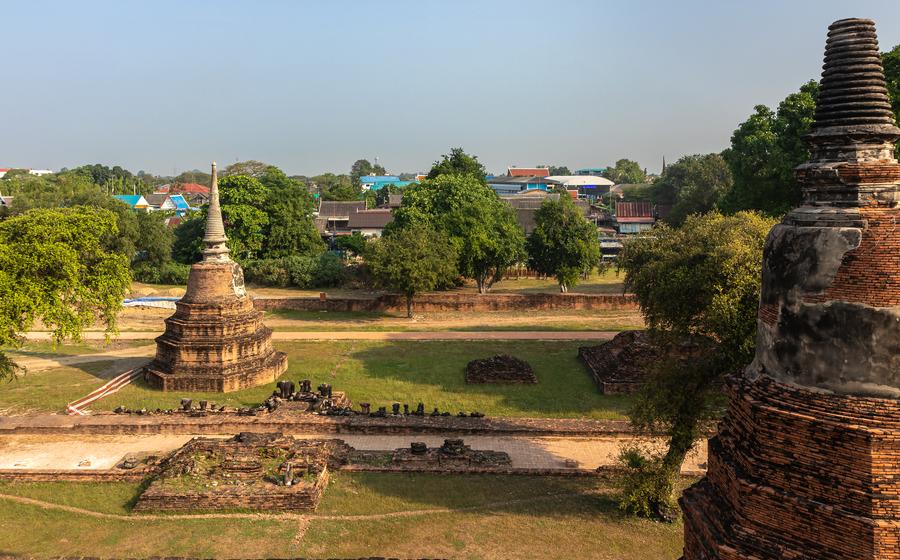
Wat Tong Pu
- Historical Significance
- Unique Architectural Features
- Impressive Buddha Images
- Serene Temple Grounds
- Local Beliefs and Legends
- Festivals and Events
- Pilgrimage Destination
- Nearby Attractions
- Getting There
- Entrance Fees and Timings
- Dress Code and Etiquette
- Photography and Videography
- Local Cuisine
- Accommodation Options
- Insider Tip: Embrace the Sunrise Serenity
Historical Significance
Wat Tong Pu holds immense historical significance as a prominent landmark in Ayutthaya. Constructed during the reign of King U-Thong in the 13th century, it initially served as a military outpost, reflecting the strategic importance of Ayutthaya as a hub for trade and defense. Later, during the Burmese occupation of Ayutthaya, the temple fell into disrepair but was subsequently restored and expanded by King Naresuan in the 16th century. This restoration marked a significant chapter in the temple's history, solidifying its status as a cultural and religious center within the Ayutthaya Kingdom. Today, Wat Tong Pu stands as a testament to the rich history of Ayutthaya and continues to attract pilgrims and visitors seeking a glimpse into Thailand's past.
Unique Architectural Features
Wat Tong Pu showcases a blend of Khmer and Thai architectural styles, reflecting the diverse cultural influences that shaped Ayutthaya. The main chedi, or stupa, is a prominent feature of the temple complex, standing tall with its octagonal base and intricate stucco decorations. The chedi's tall spire reaches towards the sky, symbolizing the temple's connection to the divine.
Other notable structures within the temple grounds include the ubosot, the main ordination hall, which houses the principal Buddha image. The ubosot's interior is adorned with beautiful murals depicting scenes from the life of Buddha and Thai history. The wiharn, or assembly hall, is another significant structure, where monks gather for religious ceremonies and teachings. The bell tower, with its distinctive shape, adds to the temple's overall architectural charm.
Impressive Buddha Images
Wat Tong Pu is home to several Buddha images, each possessing unique characteristics and holding deep religious significance for Thai Buddhists. The most revered among them is the Phra Buddha Dhammakaya, a colossal seated Buddha image that stands tall within the temple's main chedi. This majestic statue, crafted from bronze and adorned with intricate gold leaf, exudes an aura of serenity and spiritual power. It represents the ultimate embodiment of Buddha's teachings and is a focal point of worship and devotion for pilgrims and visitors alike.
In addition to the Phra Buddha Dhammakaya, Wat Tong Pu houses numerous other Buddha images scattered throughout the temple grounds. The Phra Buddha Sihing, a revered image believed to date back to the 14th century, is enshrined within the ubosot, the ordination hall. This exquisitely crafted image, carved from a single block of stone, is known for its delicate features and serene expression, capturing the essence of Buddha's compassion and wisdom.
Another notable Buddha image is the Phra Buddha Mongkolbophit, located within the wiharn, the assembly hall. This standing Buddha statue, cast in bronze, showcases intricate details and a graceful posture, embodying the strength and resilience of the Buddha's teachings. Its serene countenance and intricate ornamentation draw the attention of visitors, inviting them to contemplate the teachings of the Buddha.
These Buddha images, each possessing unique attributes and representing different aspects of the Buddha's life and teachings, contribute to the spiritual significance of Wat Tong Pu. Devotees and visitors alike come to pay homage, offer prayers, and seek blessings from these revered representations of the enlightened one, making the temple a sacred place of worship and pilgrimage.
Serene Temple Grounds
Within the temple grounds of Wat Tong Pu, a tranquil oasis awaits visitors, inviting them to immerse themselves in serenity and peace. Lush greenery surrounds the temple complex, with meticulously manicured gardens and towering trees providing shade and a sense of seclusion. The grounds are dotted with tranquil ponds, their still waters reflecting the temple's majestic structures and creating a calming ambiance.
At the heart of the temple grounds stands a majestic bodhi tree, believed to be a descendant of the original bodhi tree under which Buddha attained enlightenment. This sacred tree exudes an aura of peace and spirituality, attracting devotees and visitors alike to seek solace and inspiration beneath its sprawling branches.
Numerous Buddha statues and stupas are scattered throughout the grounds, creating a meditative environment that encourages contemplation and reflection. These sacred objects, each with its unique features and symbolism, invite visitors to pause and appreciate the beauty and profound teachings of Buddhism.
Local Beliefs and Legends
Wat Tong Pu is steeped in local beliefs and legends, adding to its mystique and cultural significance. The founding of the temple is attributed to a miraculous dream experienced by a local farmer named Thong Pu. In his dream, he was instructed to dig at a specific spot on his land, where he subsequently discovered a Buddha image. This event led to the construction of the temple and the naming of the area as "Wat Thong Pu" in honor of the farmer.
Other tales and legends associated with the temple include the belief that it is a sacred place for making wishes. Devotees who make a wish at Wat Tong Pu are said to have their wishes granted if they are sincere and pure-hearted. The temple is also believed to be a place of great spiritual power, where visitors can come to seek blessings, protection, and good fortune.
Festivals and Events
Wat Tong Pu is not only a significant historical and religious site but also a vibrant venue for various festivals and events throughout the year. These events draw both local devotees and tourists, offering a glimpse into Thai religious traditions and cultural heritage.
One of the most significant festivals held at Wat Tong Pu is the Songkran Festival, coinciding with the Thai New Year celebrations in April. During this time, the temple grounds transform into a kaleidoscope of colors, decorated with vibrant flags, lanterns, and floral arrangements. Devotees participate in water-throwing ceremonies, symbolizing purification and the washing away of sins. The temple also organizes cultural performances, traditional games, and food fairs, creating a festive and lively atmosphere.
Other notable festivals and events include the Kathin Festival in October, where devotees offer new robes to the monks as a form of merit-making. Ordination ceremonies, where young men enter the monkhood, are also held periodically, providing visitors with an opportunity to witness this sacred Buddhist ritual. These events offer a unique chance to immerse oneself in the local culture and gain insights into Thai religious practices.
Pilgrimage Destination
Wat Tong Pu holds immense significance as a pilgrimage destination, attracting devout Thai Buddhists and visitors seeking spiritual fulfillment. The temple's sacred atmosphere and rich history make it a popular destination for those seeking blessings, making merit, and connecting with their faith. Devotees often offer food and other offerings to the monks and Buddha images as a way of expressing gratitude and seeking merit. It is believed that visiting Wat Tong Pu brings good luck, prosperity, and protection, making it a popular pilgrimage site for those seeking spiritual guidance and divine blessings. The temple's serene ambiance and spiritual energy provide a sanctuary for reflection, meditation, and spiritual growth, making it an ideal destination for those seeking a deeper connection with their inner selves and the divine.
Nearby Attractions
In addition to Wat Tong Pu's captivating allure, visitors can embark on a journey to discover other enchanting destinations nearby. Immerse yourself in the rich history of the Ayutthaya Historical Park, a UNESCO World Heritage Site that unveils the grandeur of ancient temples and palaces, silently narrating tales of a bygone era. Marvel at the architectural splendor of Wat Yai Chai Mongkol, a colossal temple renowned for its colossal Buddha image, radiating serenity and inviting contemplation. Journey to the Bang Pa-In Royal Palace, a majestic riverside retreat adorned with exquisite pavilions and gardens, offering a glimpse into the opulent lifestyle of Thailand's monarchs. These nearby attractions, each possessing its unique charm, complement your visit to Wat Tong Pu, enriching your exploration of Ayutthaya's cultural and historical tapestry.
Getting There
To embark on your journey to Wat Tong Pu, you can easily travel from Bangkok, the vibrant capital of Thailand. The journey offers multiple transportation options, catering to your preferences and budget.
For a budget-friendly option, hop on a public bus from Bangkok's Southern Bus Terminal. Buses depart frequently, and the journey takes approximately 2 hours, offering a scenic ride through the Thai countryside. Alternatively, trains are a reliable and affordable mode of transport, departing from Bangkok's Hualamphong Railway Station. The train ride offers a leisurely experience, allowing you to soak in the passing landscapes.
If you prefer a more comfortable and personalized journey, consider hiring a private car or taxi. This option provides greater flexibility, allowing you to set your own pace and explore nearby attractions at your leisure. Several car rental agencies and taxi services are available in Bangkok, offering competitive rates and professional drivers.
Once in Ayutthaya, Wat Tong Pu is conveniently located within the city center, making it easily accessible by local transportation. Tuk-tuks, the iconic three-wheeled vehicles, are a popular choice for short-distance travel and offer a fun and authentic experience. Alternatively, you can opt for a bicycle rental, allowing you to explore the city at your own pace while enjoying the fresh air and picturesque surroundings.
Entrance Fees and Timings
Visiting Wat Tong Pu is generally free of charge, allowing visitors to explore its sacred grounds and admire its architectural wonders without any financial burden. However, certain events or festivals held within the temple may require a nominal entrance fee to cover maintenance costs or support specific religious ceremonies.
The temple's opening hours are from 8:00 AM to 5:00 PM daily, providing ample time for visitors to explore its various structures, pay homage to the Buddha images, and immerse themselves in the serene atmosphere. It is advisable to plan a visit during these hours to avoid disappointment, as the temple may be closed on specific days or during special ceremonies.
Dress Code and Etiquette
When visiting Wat Tong Pu, it is essential to observe proper dress code and etiquette to show respect for Thai cultural norms and religious customs. Visitors should dress modestly, covering their shoulders and knees. Avoid wearing revealing or inappropriate clothing, such as shorts, tank tops, or swimwear. It is also important to be respectful and mindful of the temple's sacred environment. Maintain silence, avoid disruptive behavior, and refrain from pointing your feet at Buddha images, which is considered disrespectful. When entering the temple, remove your shoes and place them neatly on the designated racks.
Photography and Videography
Photography and videography are generally allowed at Wat Tong Pu for personal use. Visitors are encouraged to capture the temple's beauty and share their experiences with others. However, it is important to be respectful and mindful of the temple's sacred environment. Avoid using flash photography, as it can be disruptive to other visitors and damage the temple's delicate artwork. Commercial photography or filming may require prior permission from the temple authorities. Please be respectful when taking photos or videos, and avoid disturbing other visitors or disrupting religious ceremonies.
Local Cuisine
After exploring the sacred grounds of Wat Tong Pu, indulge in the delectable flavors of authentic Thai cuisine. Several local restaurants and eateries are situated near the temple, offering a tantalizing array of dishes to satisfy your taste buds. Pad Thai, a beloved national dish, is a must-try, featuring stir-fried rice noodles tossed with a savory sauce, fresh vegetables, and your choice of protein. Khao soi, a northern Thai specialty, is another popular choice, consisting of egg noodles in a rich coconut-based curry broth, often accompanied by crispy fried noodles and pickled mustard greens. For a refreshing and tangy treat, sample som tum, a spicy green papaya salad made with shredded unripe papaya, tomatoes, garlic, chili peppers, and lime juice. If you're feeling adventurous, try khanom jeen, a set of fermented rice noodles served with various dipping sauces and toppings, such as curries, vegetables, and herbs. Don't forget to complement your meal with a refreshing glass of Thai iced tea or a sweet dessert like mango sticky rice or coconut ice cream.
Accommodation Options
When planning your visit to Wat Tong Pu, a range of accommodation options are available nearby to suit different budgets and preferences. For a comfortable and convenient stay, consider booking a room at one of the nearby hotels or guesthouses. These establishments offer a variety of amenities, including air-conditioned rooms, private bathrooms, and often, stunning views of the temple grounds.
For a more authentic and immersive experience, opt for a homestay with a local family. This is a great way to learn about Thai culture and daily life, as well as enjoy delicious home-cooked meals. Several homestays are located within walking distance of Wat Tong Pu, allowing you to fully embrace the temple's serene atmosphere.
If you're seeking a unique and memorable experience, consider staying at one of the charming boutique hotels or resorts in the area. These establishments often feature traditional Thai architecture, lush gardens, and personalized service, making your stay extra special.
No matter your budget or preferences, you're sure to find an accommodation option near Wat Tong Pu that meets your needs and ensures a comfortable and enjoyable stay.
Insider Tip: Embrace the Sunrise Serenity
For an unforgettable experience, plan your visit to Wat Tong Pu during the early morning hours to witness the sunrise. As the first rays of sunlight illuminate the temple grounds, the atmosphere transforms into a magical spectacle. The glistening chedi and Buddha images cast long shadows, creating a serene and meditative ambiance. Embrace the tranquility of the surroundings and find a peaceful spot to enjoy the sunrise, reflecting on the temple's rich history and spiritual significance. This serene moment will leave a lasting impression and provide a unique perspective on the beauty of Wat Tong Pu.
